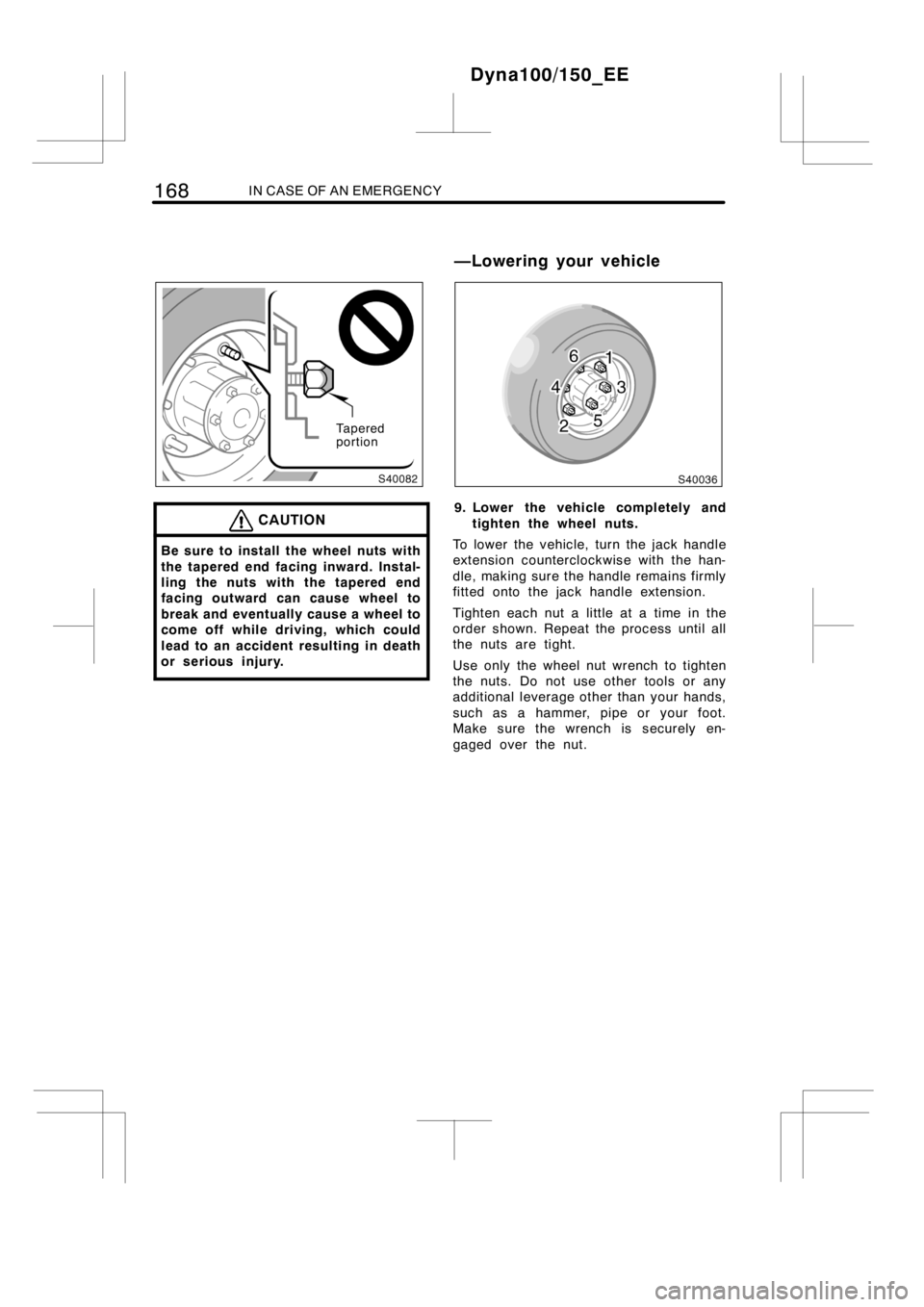2012 TOYOTA DYNA 100/150 break
[x] Cancel search: breakPage 121 of 240

INFORMATION BEFORE DRIVING YOUR TOYOTA11 5
Section 2
INFORMATION BEFORE DRIVING YOUR
TOYOTA
DBreak−in period 116...................................
DFuel 116..............................................
DOperation in foreign countries 118.......................
DDPF system 118.......................................
DEngine exhaust cautions 122...........................
DFacts about engine oil consumption 123.................
DBrake system 124.....................................
DBrake pad wear indicators 127..........................
DLuggage stowage precautions 127......................
DLimited−slip differential 128.............................
DYour Toyota’s identification 128.........................
DSuspension and chassis 130............................
Dyna100/150_EE
Page 122 of 240

11 6INFORMATION BEFORE DRIVING YOUR TOYOTA
Drive gently and avoid high speeds.
Your vehicle does not need an elaborate
break−in. But following a few simple tips
for the first 1000 km (600 miles) can add
to the future economy and long life of
your vehicle:
DAvoid full throttle acceleration when
starting and driving.
DAvoid racing the engine.
DTry to avoid hard stops during the first
300 km (200 miles).
DDo not drive slowly with the manual
transmission in a high gear.
DDo not drive for a long time at any
single speed, either fast or slow.
DDo not tow a trailer during the first 800
km (500 miles).Selecting the proper fuel is essential
for satisfactory engine performance.
Engine damage caused by use of improp-
er fuels is not covered under Toyota’s new
vehicle warranty.
NOTICE
zDo not use improper fuels. If im-
proper fuels are used the engine
will be damaged.
zDo not use a fuel that contains
more than 50 ppm of sulfur. Use of
such a high sulfur fuel may damage
the engine.
zEU area: FAME (Fatty Acid Methyl
Ester) fuel sold under names such
as “B30” or “B100” and fuel
containing a large amount of FAME
should not be used. The use of
these fuels will damage the ve-
hicle’s fuel system. In case of any
doubt, ask any authorized Toyota
dealer or repairer, or another duly
qualified and equipped professional.
zExcept EU area: FAME (Fatty Acid
Methyl Ester) fuel sold under names
such as “B30” or “B100” and fuel
containing a large amount of FAME
should not be used. Your vehicle
can use diesel mixed with 5% max
biodiesel FAME (B5). The use of
fuel with more than 5% FAME con-
tent (B5) will damage the vehicle’s
fuel system. You must ensure that
refueling is carried out only from a
source where fuel specification and
quality can be guaranteed. In case
of any doubt, ask any authorized
Toyota dealer or repairer, or anoth-
er duly qualified and equipped pro-
fessional.
Dyna100/150_EE
Break−in period Fuel
Page 150 of 240

144STARTING AND DRIVING
TIRES
DEnsure that your vehicle’s tires are
properly inflated. See page 201 in Sec-
tion 7−2 and page 226 in Section 8 for
instructions.
DThe trailer tires should be inflated to
the pressure recommended by the trail-
er manufacturer in respect to the total
trailer weight.
TRAILER LIGHTS
DCheck for correct operation of the turn
signals and stop lights each time you
hitch up. Direct splicing may damage
your vehicle’s electrical system and
cause a malfunction of your lights.
BREAK−IN SCHEDULE
DToyota recommends that you do not
tow a trailer with a new vehicle or a
vehicle with any new power train com-
ponent (engine, transmission, differen-
tial, wheel bearing, etc.) for the first
800 km (500 miles) of driving.
MAINTENANCE
DIf you tow a trailer, your vehicle will
require more frequent maintenance due
to the additional load.
DRetighten all fixing bolts of the towing
ball and bracket after approximately
1000 km (600 miles) of trailer driving.
PRE−TOWING SAFETY CHECK
DBe sure not to exceed designated max-
imum load for the ball coupling of the
towing bracket. Please remember that
the ball coupling load will increase the
load on the vehicle. Maximum permissi-
ble rear axle capacity must not be ex-
ceeded.
DMake sure the trailer cargo is securely
loaded so that it cannot shift.
DIf the traffic behind the trailer cannot
be seen properly with the standard rear
view mirrors, additional outside mirrors
will be necessary. Both outside mirrors
must be fitted on folding arms and ad-
justed to give a good rear view at all
times.
TRAILER TOWING TIPS
Your vehicle will handle differently
when towing a trailer. In order to avoid
accident, death or serious injury, keep
the following in mind when towing:
DBefore starting out, check operation of
the lights and all vehicle−trailer connec-
tions. After driving a short distance,
stop and recheck the lights and con-
nections. Before actually towing a trail-
er, practice turning, stopping and back-
ing with a trailer in an area away from
traffic until you learn the feel.
DBecause stopping distance may be in-
creased, vehicle−to−vehicle distance
should be increased when towing a
trailer. For each 10 km/h (6 mph) of
speed, allow at least one vehicle and
trailer length between you and the ve-
hicle ahead. Avoid sudden braking as
you may skid, resulting in jackknifing
and loss of control. This is especially
true on wet or slippery surfaces.
DAvoid jerky starts or sudden accelera-
tion. Prevent excessive clutch slippage
by keeping engine rpm low and not
racing the engine. Always start out in
first gear.
DAvoid jerky steering and sharp turns.
The trailer could hit your vehicle in a
tight turn. Slow down before making a
turn to avoid the necessity of sudden
braking.
Dyna100/150_EE
Page 174 of 240

168IN CASE OF AN EMERGENCY
Tapered
portion
CAUTION
Be sure to install the wheel nuts with
the tapered end facing inward. Instal-
ling the nuts with the tapered end
facing outward can cause wheel to
break and eventually cause a wheel to
come off while driving, which could
lead to an accident resulting in death
or serious injury.
9. Lower the vehicle completely and
tighten the wheel nuts.
To lower the vehicle, turn the jack handle
extension counterclockwise with the han-
dle, making sure the handle remains firmly
fitted onto the jack handle extension.
Tighten each nut a little at a time in the
order shown. Repeat the process until all
the nuts are tight.
Use only the wheel nut wrench to tighten
the nuts. Do not use other tools or any
additional leverage other than your hands,
such as a hammer, pipe or your foot.
Make sure the wrench is securely en-
gaged over the nut.
Dyna100/150_EE
—Lowering your vehicle
Page 179 of 240

IN CASE OF AN EMERGENCY173
If towing is necessary, we recommend
you to have it done by any authorized
Toyota dealer or repairer, or qualified
professional, such as a commercial tow
truck service.
If towing service is not available in an
emergency, your vehicle may be tempo-
rarily towed by a cable or chain se-
cured to one of the following parts:
Front: Front emergency towing hook
Rear: Rear emergency towing eyelet
Use extreme caution when towing the
vehicle.
NOTICE
Only use specified towing hook or
eyelet; otherwise your vehicle may be
damaged.
A driver must be in the vehicle to steer
it and operate the brakes.
Towing in this manner may be done only
on hard−surfaced roads for a short dis-
tance and at low speeds. Also, the
wheels, axles, drive train, steering and
brakes must all be in good condition.
CAUTION
Use extreme caution when towing the
vehicle. Avoid sudden starts or errat-
ic driving maneuvers which would
place excessive stress on the emer-
gency towing hook or eyelet and tow-
ing cable or chain. The hook or eye-
let and towing cable or chain may
break and cause serious injury or
damage.
NOTICE
Use only a cable or chain specifically
intended for use in towing vehicles.
Securely fasten the cable or chain to
the towing hook or eyelet provided.
Before towing, release the parking brake
and put the transmission in neutral. The
engine switch must be in “ACC” (engine
off) or “ON” (engine running) position.
CAUTION
If the engine is not running, the pow-
er assist for the brakes and steering
will not work so steering and braking
will be much harder than usual.
Dyna100/150_EE
Page 180 of 240

174IN CASE OF AN EMERGENCY
DBefore emergency towing, check that
the hook or eyelet is not broken or
damaged and that the installation bolts
are not loose.
DFasten the towing cable or chain se-
curely to the hook or eyelet.
DDo not jerk the hook or eyelet. Apply
steady and even force.
DTo avoid damaging the hook or eyelet,
do not pull from the side or at a verti-
cal angle. Always pull straight ahead.You can purchase a new key at any
authorized Toyota dealer or repairer, or
another duly qualified and equipped
professional, if you can give them the
key number.
See the suggestion given in “Keys” on
page 12 in Section 1−2.
If your key is locked in the vehicle and
you cannot get a duplicate, many autho-
rized Toyota dealers, repairers or other
duly qualified and equipped professionals
can still open the door for you, using their
special tools. If you must break a window
to get in, we suggest breaking the side
window because it is the least expensive
to replace. Be extremely cautious to avoid
cuts from the glass.
Dyna100/150_EE
—Emergency towing hook or
eyelet precautionsIf you lose your keys
Page 236 of 240

230INDEX
A
Adding washer fluid 212..................
Adjustment
Driver ’s seat 25.......................
Seat belt 28...........................
Air bleeding 150.........................
Air conditioning filter 101.................
Air conditioningsystem 92...............
Airbag 38...............................
Anti−lock brake system
warning light 73.......................
Anti−theft steering column lock 80........
Appearance care
Cleaning the interior 181...............
Protecting your Toyota from
corrosion 178.......................
Washing and waxing 179...............
Audio system 84........................
Audio systemoperating tips 89...........
Auxiliary box 110........................
B
Battery
Access 190...........................
Checking battery condition 208.........
Gas caution 208.......................
Handling safety 208...................
Recharging precautions 210............
Winter driving tips 137.................
Before starting the engine 132............
Brake pad wear indicators 127............
Brake system 124.......................
Brake system warning light 73............
Brakes
Pad wear indicators 127................
Parking 82............................
Break−in tips 116........................
C
Carbon monoxide caution 122............
Card holder 112.........................
Center console box 111..................
Charging system warning light 73.........
Checking and replacing fuses 211........
Checking the engine oil level 196.........
Checking the radiator, condenser and
intercooler 200........................Child restraint
Child restraint system 45...............
Installation 48,51......................
Precautions 44........................
Types of child restraint system 46.......
Cigarette lighter and ashtrays 108........
Cleaning the interior 181.................
Cold weather
Operation 137.........................
Condenser
Checking the condenser 200...........
Controls, Instrument panel 2,6...........
Cooling system
Coolant level 198......................
Engine overheating 156................
Radiator and reservoir 198.............
Radiator cap 156......................
Winter driving tips 137.................
Corrosion prevention 178................
Cup holder 110..........................
D
Diesel particulate filter system 118........
Differential, Limited slip 128..............
Dimmer switch, Headlight 62.............
Directional signals 62....................
Do−it−yourself maintenance
Service precautions 193...............
Does your vehicle need repairing? 185....
Doors
Side doors 13.........................
DPF system 118.........................
Driver ’s seat 25.........................
Driving
Driving tips 132........................
Manual transmission 81................
Driving in the rain 136....................
Driving tips
Driving in the rain 136..................
Driving tips in various conditions 135....
Driving with a manual
transmission 81.....................
Economical driving 146................
Good driving practice 81...............
Pre−trip safety check 134..............
Winter driving tips 137.................
During
Break−in 116..........................
Dyna100/150_EE
Page 238 of 240

232INDEX
G
Gauge
Engine coolant temperature 68.........
Fuel 68...............................
Glove box 109...........................
Good driving practice 81.................
H
Hazard switch 64........................
Head restraints 27.......................
Headlight beam level control dial 63.......
Headlight switch 62......................
Heater idle up switch 101.................
High speed operation
During break−in 116...................
How to start the engine 132...............
I
Identification
Engine 130............................
Vehicle 128...........................
Ignition switch 80........................
Indicator symbols 8.....................
Instrument panel
Cigarette lighter and ashtrays 108......
Fuel gauge 68.........................
Indicator symbols 8....................
Odometer 70..........................
Tachometer 69........................
Trip meter 70..........................
Instrument panel overview 2,6...........
Intercooler
Checking the intercooler 200...........
J
Jack
Location 158..........................
Jump starting 151.......................
K
Keys 12,174............................
L
Light bulbs
Back−up lights 217....................
Front position lights 216................
Front turn signal lights 216.............
Headlights 214........................
License plate lights 218................
Rear fog light 218......................
Rear turn signal lights 217..............
Side turn signal lights 216..............
Stop/tail lights 217.....................
Light bulbs, Replacing 213...............
Light reminder buzzer 73.................
Light, Interior
Interior light 65........................
Limited slip differential 128...............
Lock
Side doors 13.........................
Side gate 16..........................
Steering column 80....................
Tailgate 16............................
Low brake fluid level warning light 73......
Low engine oil level warning light 73......
Low engine oil pressure
warning light 73.......................
Low fuel level warning light 73............
Low vacuum warning light 73.............
Luggage stowage precautions 127........
M
Maintenance
Do−it−yourself maintenance 193........
Does your vehicle need
repairing? 185.......................
Maintenance facts 184.................
Where to go for service 184............
Malfunction indicator lamp 73............
Manual regeneration switch,
Diesel particulate filter system 118......
Manual transmission
Driving with a manual
transmission 81.....................
Shift pattern 81........................
Maximum allowable speed
Manual transmission 81................
Mirrors
Folding rear view 59...................
Outside rear view 59...................
Dyna100/150_EE